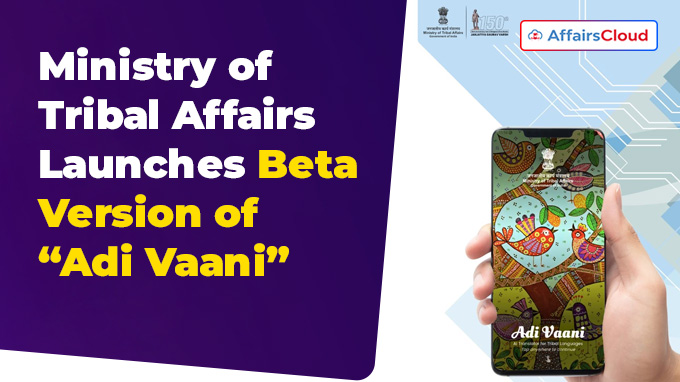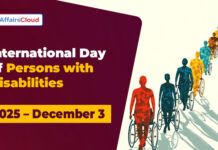 In August 2025, the Ministry of Tribal Affairs (MoTA), announced the launch of the Beta Version of ‘Adi Vaani’ – India’s first Artificial Intelligence (AI) powered translator for Tribal languages.
In August 2025, the Ministry of Tribal Affairs (MoTA), announced the launch of the Beta Version of ‘Adi Vaani’ – India’s first Artificial Intelligence (AI) powered translator for Tribal languages.
- Adi Vaani leverages AI to systematically digitize, preserve, and revitalize tribal languages, addressing the challenge of their decline.
Exam Hints:
- What? Launch of Adi Vaani, AI-powered tribal language translator
- Launched by :MoTA
- Developed by: IIT Delhi, BITS Pilani, IIIT Hyderabad, IIIT Nava Raipur and TRIs.
- Adi Vaani: AI tool to safeguard tribal languages
- Languages: Santali, Bhili, Mundari, Gondi
- Objective: Safeguard, preserve & revitalize tribal languages
About Adi Vaani:
Overview: It is an AI-powered translation tool envisioned as the groundwork for developing a future large language model focused on tribal languages.
- The project integrates advanced AI technologies with community-led initiatives to safeguard, promote, and rejuvenate tribal languages and cultures across India.
Collaboration: Developed by a national consortium of premier institutions led by the Indian Institute of Technology, Delhi (IIT-D), along with Birla Institute of Technology and Science, Pilani (BITS Pilani), International Institute of Information Technology, Hyderabad (IIIT-H), and International Institute of Information Technology, Naya Raipur (IIIT-NR), in collaboration with Tribal Research Institutes (TRIs) in Jharkhand, Odisha, Madhya Pradesh (MP), Chhattisgarh, and Meghalaya.
Objectives: The project aims to:
- Enable real-time translation (text and speech) between Hindi/English and tribal languages.
- Provide interactive language learning for students and early learners.
- Digitally preserve folklore, oral traditions, and cultural heritage.
- Support digital literacy, healthcare communication, and civic inclusion in tribal communities.
- Awareness on government schemes and important speeches.
Languages: In its Beta launch, Adi Vaani will support – Santali (Odisha), Bhili (MP), Mundari (Jharkhand), Gondi (Chhattisgarh).
- Additional languages including Kui and Garo are under development for the next phase.
Methodology and Features:
AI Language Models: Refined deployment of models such as No Language Left Behind (NLLB) and IndicTrans2 for low-resource tribal languages.
Functional Toolkit:
- Text-to-Text, Text-to-Speech, Speech-to-Text, Speech-to-Speech translations.
- Optical Character Recognition (OCR) for digitizing manuscripts and primers.
- Bilingual dictionaries and curated repositories.
- Subtitles for Prime Minister’s speeches, health advisories (e.g., Sickle Cell Disease awareness), and information on government schemes and initiatives in tribal languages.
Integration: This initiative supports India’s constitutional values of diversity and equality while promoting major national programs like Digital India, Ek Bharat Shreshtha Bharat, Adi Karmayogi Abhiyan, Dharti Aaba Janjatiya Gram Utkarsh Abhiyan, and Pradhan Mantri Janjati Adivasi Nyaya Maha Abhiyan(PM JANMAN).
Impact: Safeguard tribal knowledge systems and cultural expressions through systematic digitization.
- Enable tribal communities with access to education, healthcare, and public services in their native languages.
India’s Linguistic Landscape:
Tribal Languages: India is home to 461 tribal languages spoken by Scheduled Tribes (ST) and 71 distinct tribal mother tongues (Census of India, 2011).
- Among them, 81 languages are classified as vulnerable and 42 as critically endangered, with many at risk of extinction owing to inadequate documentation and gaps in intergenerational transmission.
About Ministry of Tribal Affairs(MoTA):
Union Minister – Jual Oram (Constituency – Sundargarh, Odisha)
Minister of State (MoS) – Durga Das Uikey (Constituency – Betul, Madhya Pradesh, MP)




